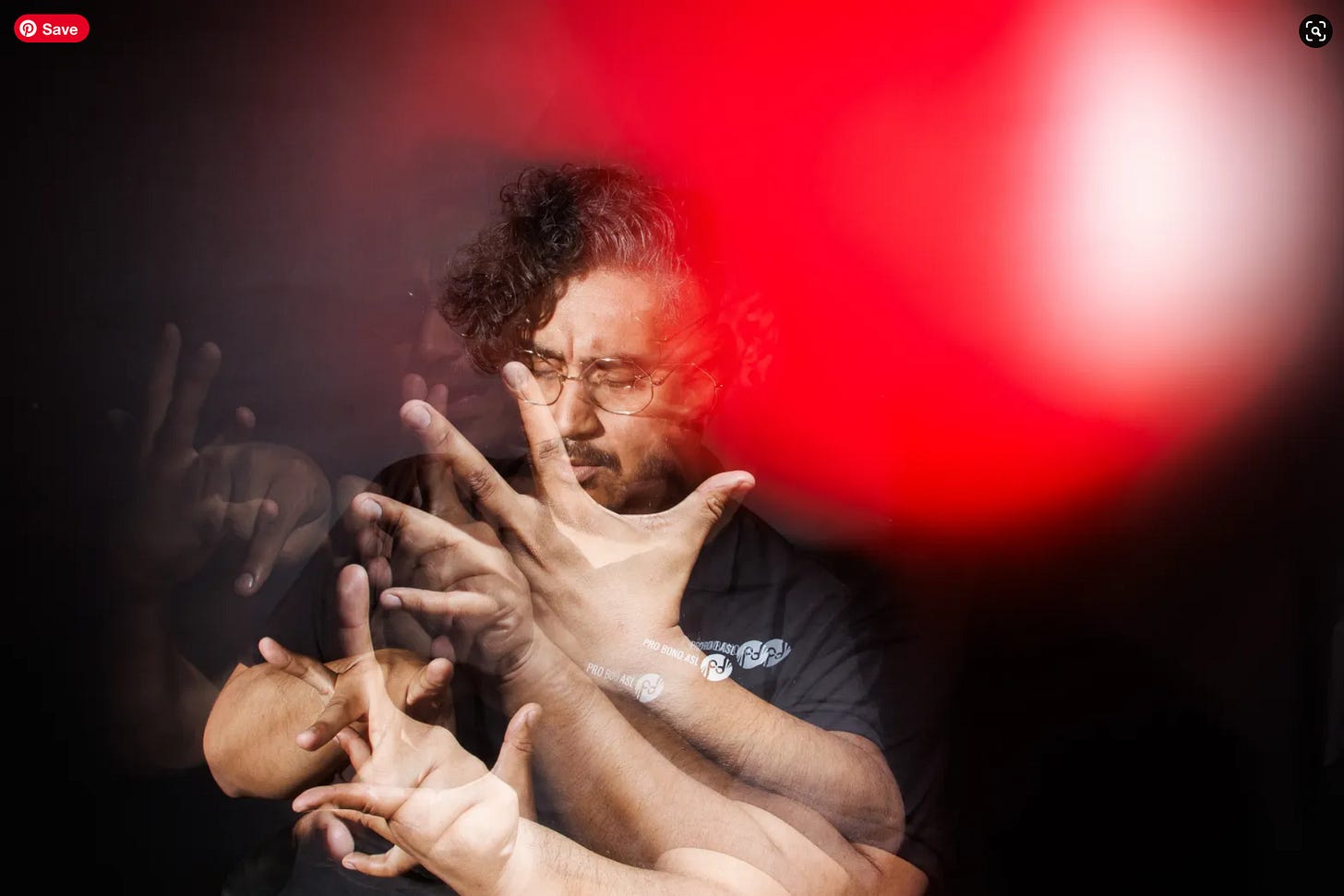SIGNING IS THE MOST BEAUTIFUL SINGING THE WORLD HAS EVER SEEN
Silence, to Deaf people, who are intensely visual people, isn't lack of sound; it’s lack of movement

by Paul Hostovsky
It may sound oxymoronic, but there is music in sign language. Even if you don’t understand a word of it, you probably enjoy looking at it. Most people do. They say it’s beautiful and expressive, that it kind of looks like dancing. And if you’re like most hearing people, you probably also enjoy listening to music. In fact, you might say you can’t imagine a life without music. Well, ASL has its own music, and when you watch Deaf people signing—and especially when you understand every word of it—you can see the music.
Sign language, in the hands of Deaf people, isn’t linear the way spoken languages are linear–one discrete word following on the heels of the next. Rather, ASL is symphonic. It creates meaning simultaneously with the hands, face, eyebrows, eye-gaze, lips, tongue, head-tilt, shoulder-turn—all the various sections of the body’s orchestra creating meaning at the same time. A visual-gestural symphony rising up all at once, like a controlled explosion.
ASL has its own rhythms, assonances, crescendos and decrescendos, riffs and repetitions, most of which have grammatical functions. For example, one beat versus two can indicate the difference between a verb and a noun; a single movement versus a repeated movement can be the difference between simple present and present continuous, or between modified and unmodified verbs. Additionally, much of the grammar of ASL occurs on the face, such as negation, imperatives, interrogatives, adjectives, adverbs, and something called ‘sound imagery’, a way of visually representing certain environmental sounds with the lips, teeth, tongue and eyes. Hearing people often comment that Deaf people are very animated. And while it’s true that facial expression in ASL also expresses emotion, it’s usually more about grammar than emotion, more about sense than sensibility. More semantic than romantic.
And the thing is, it feels good to sign. The physical pleasure one derives from signing and watching other people signing is not unlike the physical pleasure one derives from making music and listening to music being made. Interestingly, sign and sing, but for two inverted letters, are the same word. A happy accident? Perhaps. And yet, signing and singing are just two different (or maybe not so different) ways that the body expresses energy, shaping meaning and emotion out of thin air, putting it out there for the world to take in. And the manual dexterity required to play a musical instrument is not unlike the manual dexterity required to articulate the handshapes and movements of ASL. In fact, ASL teachers report that hearing people who have learned to play a musical instrument at some point in their lives seem to have an easier time learning ASL than those who never played a musical instrument. Go figure.
But silence, to Deaf people, who are intensely visual people, isn't lack of sound; it’s lack of movement. Sound IS movement, in fact. It’s energy moving in waves. Which is what music is, after all. And when Deaf people look into the faces of hearing people, what they usually see is silence. They see silence because hearing people, for the most part, do not use their faces to express meaning or emotion. Compared to Deaf people, they have very little facial expression when they talk. Hearing people are pretty poker-faced, if you ask Deaf people. And that’s because their intonation is all in the voice, which is invisible to Deaf people.
But when Deaf people look into the faces of other Deaf people, what do you think they see? They see music! Movement, beauty, energy, meaning. They see intonation. They see gymnastic eyebrows, eloquent eyes, adverbial tongues, and all the risible muscles being put to good, resounding use. They see their language, a visually stunning and musical language, full of inflection, anima, soul.
Hearing people who don’t know ASL can, of course, see the hands and faces and bodies of Deaf people signing, but they can’t really appreciate the music of it, not if they don’t understand what they’re seeing. But when you understand what you’re seeing, you’re wowed by the creativity, the echoes, the prosody, the embodiments and shifts, the flights of playfulness and artfulness, the cinematic effects, so much so that it almost makes you want to stand up and applaud.
Submit to Cripple Punk Mag- We need your voice! Seeking: Essays, criticism, news and reviews, literary nonfiction, fiction, rants and raves, comics, and beyond.




